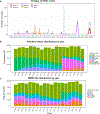Primary exposure to Zika virus is linked with increased risk of symptomatic dengue virus infection with serotypes 2, 3, and 4, but not 1
- PMID: 38809964
- PMCID: PMC11927040
- DOI: 10.1126/scitranslmed.adn2199
Primary exposure to Zika virus is linked with increased risk of symptomatic dengue virus infection with serotypes 2, 3, and 4, but not 1
Abstract
Infection with any of the four dengue virus serotypes (DENV1-4) can protect against or enhance subsequent dengue depending on preexisting antibodies and infecting serotype. Additionally, primary infection with the related flavivirus Zika virus (ZIKV) is associated with increased risk of DENV2 disease. Here, we measured how prior DENV and ZIKV immunity influenced risk of disease caused by DENV1-4 in a pediatric Nicaraguan cohort. Of 3412 participants in 2022, 10.6% experienced dengue cases caused by DENV1 (n = 139), DENV4 (n = 133), DENV3 (n = 54), DENV2 (n = 9), or an undetermined serotype (n = 39). Longitudinal clinical and serological data were used to define infection histories, and generalized linear and additive models adjusted for age, sex, time since last infection, and year, and repeat measurements were used to predict disease risk. Compared with flavivirus-naïve participants, primary ZIKV infection was associated with increased risk of disease caused by DENV4 (relative risk = 2.62, 95% confidence interval: 1.48 to 4.63) and DENV3 (2.90, 1.34 to 6.27), but not DENV1 infection. Primary DENV infection or DENV followed by ZIKV infection was also associated with increased risk of DENV4 disease. We reanalyzed 19 years of cohort data and demonstrated that prior flavivirus immunity and antibody titer had distinct associations with disease risk depending on incoming serotype. We thus find that prior ZIKV infection, like prior DENV infection, is associated with increased risk of disease with certain DENV serotypes. Cross-reactivity among flaviviruses should be considered when assessing vaccine safety and efficacy.
Conflict of interest statement
Figures






Update of
-
Primary exposure to Zika virus increases risk of symptomatic dengue virus infection with serotypes 2, 3, and 4 but not serotype 1.medRxiv [Preprint]. 2023 Nov 30:2023.11.29.23299187. doi: 10.1101/2023.11.29.23299187. medRxiv. 2023. Update in: Sci Transl Med. 2024 May 29;16(749):eadn2199. doi: 10.1126/scitranslmed.adn2199. PMID: 38077039 Free PMC article. Updated. Preprint.
Similar articles
-
Primary exposure to Zika virus increases risk of symptomatic dengue virus infection with serotypes 2, 3, and 4 but not serotype 1.medRxiv [Preprint]. 2023 Nov 30:2023.11.29.23299187. doi: 10.1101/2023.11.29.23299187. medRxiv. 2023. Update in: Sci Transl Med. 2024 May 29;16(749):eadn2199. doi: 10.1126/scitranslmed.adn2199. PMID: 38077039 Free PMC article. Updated. Preprint.
-
Zika virus infection enhances future risk of severe dengue disease.Science. 2020 Aug 28;369(6507):1123-1128. doi: 10.1126/science.abb6143. Science. 2020. PMID: 32855339 Free PMC article.
-
Primary and Secondary Dengue Virus Infections Elicit Similar Memory B-Cell Responses, but Breadth to Other Serotypes and Cross-Reactivity to Zika Virus Is Higher in Secondary Dengue.J Infect Dis. 2020 Jul 23;222(4):590-600. doi: 10.1093/infdis/jiaa120. J Infect Dis. 2020. PMID: 32193549 Free PMC article.
-
Cross-Reactive T Cell Immunity to Dengue and Zika Viruses: New Insights Into Vaccine Development.Front Immunol. 2019 Jun 11;10:1316. doi: 10.3389/fimmu.2019.01316. eCollection 2019. Front Immunol. 2019. PMID: 31244855 Free PMC article. Review.
-
Modulation of Dengue/Zika Virus Pathogenicity by Antibody-Dependent Enhancement and Strategies to Protect Against Enhancement in Zika Virus Infection.Front Immunol. 2018 Apr 23;9:597. doi: 10.3389/fimmu.2018.00597. eCollection 2018. Front Immunol. 2018. PMID: 29740424 Free PMC article. Review.
Cited by
-
Complement-dependent virion lysis mediated by dengue-Zika virus cross-reactive antibodies correlates with protection from severe dengue disease.medRxiv [Preprint]. 2024 Jun 4:2024.06.03.24308395. doi: 10.1101/2024.06.03.24308395. medRxiv. 2024. Update in: Cell Rep. 2025 May 27;44(5):115613. doi: 10.1016/j.celrep.2025.115613. PMID: 38883768 Free PMC article. Updated. Preprint.
-
Enhancing capacities in genomic surveillance capabilities for SARS-CoV-2 and dengue virus: A South-South collaborative partnership.PLOS Glob Public Health. 2025 Apr 8;5(4):e0004365. doi: 10.1371/journal.pgph.0004365. eCollection 2025. PLOS Glob Public Health. 2025. PMID: 40198614 Free PMC article.
-
Zika virus: an overview update.Curr Opin HIV AIDS. 2025 May 1;20(3):294-302. doi: 10.1097/COH.0000000000000926. Epub 2025 Mar 17. Curr Opin HIV AIDS. 2025. PMID: 40048580 Free PMC article. Review.
-
One-Pot Expression and Assembly of Resurfaced Zika Virus E Domain III Nanoparticle Immunogens in Mammalian Cells.ACS Omega. 2025 Jun 2;10(23):25068-25075. doi: 10.1021/acsomega.5c03059. eCollection 2025 Jun 17. ACS Omega. 2025. PMID: 40547701 Free PMC article.
-
Zika Virus-A Reemerging Neurotropic Arbovirus Associated with Adverse Pregnancy Outcomes and Neuropathogenesis.Pathogens. 2024 Feb 15;13(2):177. doi: 10.3390/pathogens13020177. Pathogens. 2024. PMID: 38392915 Free PMC article. Review.
References
-
- Cattarino L, Rodriguez-Barraquer I, Imai N, Cummings DAT, Ferguson NM, Mapping global variation in dengue transmission intensity. Sci. Transl. Med. 12, eaax4144 (2020). - PubMed
-
- Faria NR, Quick J, Claro IM, Theze J, de Jesus JG, Giovanetti M, Kraemer MUG, Hill SC, Black A, da Costa AC, Franco LC, Silva SP, Wu CH, Raghwani J, Cauchemez S, du Plessis L, Verotti MP, de Oliveira WK, Carmo EH, Coelho GE, Santelli ACFS, Vinhal LC, Henriques CM, Simpson JT, Loose M, Andersen KG, Grubaugh ND, Somasekar S, Chiu CY, Munoz-Medina JE, Gonzalez-Bonilla CR, Arias CF, Lewis-Ximenez LL, Baylis SA, Chieppe AO, Aguiar SF, Fernandes CA, Lemos PS, Nascimento BLS, Monteiro HAO, Siqueira IC, de Queiroz MG, de Souza TR, Bezerra JF, Lemos MR, Pereira GF, Loudal D, Moura LC, Dhalia R, Franca RF, Magalhaes T, Marques ET Jr., Jaenisch T, Wallau GL, de Lima MC, Nascimento V, de Cerqueira EM, de Lima MM, Mascarenhas DL, Neto JPM, Levin AS, Tozetto-Mendoza TR, Fonseca SN, Mendes-Correa MC, Milagres FP, Segurado A, Holmes EC, Rambaut A, Bedford T, Nunes MRT, Sabino EC, Alcantara LCJ, Loman NJ, Pybus OG, Establishment and cryptic transmission of Zika virus in Brazil and the Americas. Nature 546, 406–410 (2017). - PMC - PubMed
Publication types
MeSH terms
Substances
Grants and funding
LinkOut - more resources
Full Text Sources
Medical

